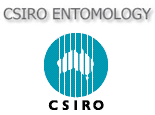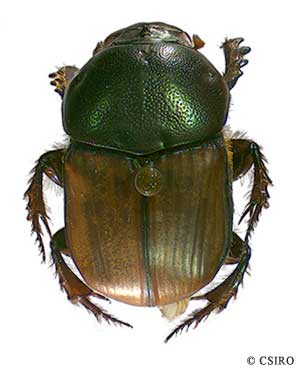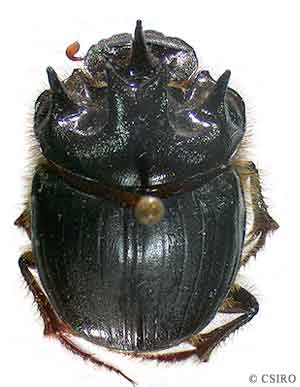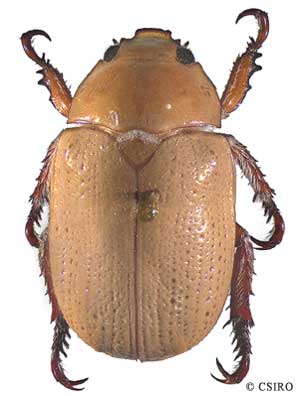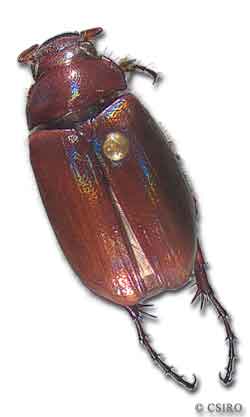|
This
beetle family is second only to the Curculionidae in the number
of species it contains, with over 2000 species currently described
in Australia. They are small to large beetles and range in size
from 2-70 millimetres in length depending on the species. Scarab
beetles are adapted for burrowing and have well developed tibiae
on their forelegs for digging. Most adults are stoutly built and
have a plate known as the 'clypeus', which hides their mandibles
when viewed from above. Some species of scarabs have prominent horns
on their head or pronotum, which in some species is used for fighting
off competing males.
The
larvae of scarabs are distinctly C-shaped and mostly feed on fresh or
decaying vegetable matter. Some species feed on decaying animal matter
or the dung of native or introduced animals. Adult scarabs mostly feed
on leaves and some species such as the well known Christmas beetles can
build to huge numbers, devouring almost all leaves on favoured eucalyptus
trees. Some scarab species are also known to feed on the nectar of native
blossoms.
|
|
|
Onitis
alexis
(bronze
dung beetle)
|
|
Onitis
alexis is often found around lights at night and is recognisable
by its squarish appearance and metallic sheen. It is a medium
sized beetle which grows to about 18 millimetres in length.
Onitis alexis is a dung beetle, which was introduced from
Africa to improve Australian pastures. It is now well established
in Australia and can be found across most of the country. This
species helps break down cattle dung because the native dung beetles
only like to feed on the dung of Australian native animals. Adults
are active at dawn and dusk and are usually attracted to the dung
of cattle. When they locate a fresh dung pad, adults will land
to feed on the liquids and construct burrows in the soil beneath
the pads. These burrows are provisioned with the dung which is
formed into balls and serves as food for their developing larvae.
This burying action assist in the breakdown of large amounts of
dung, which native dung beetles are mainly not adapted for.
|
|
|
|
Onthophagus
pentacanthus
(five
horned dung beetle)
|
|
Many
scarab beetles have large horns on their heads which are often
used to fight other male beetles. Onthophagus pentacanthus
can grow to be approximately 18 millimetres in length and has
quite prominent horns for its size. This species is a native dung
beetle and is common throughout much of the Murray-Darling basin
and further west in South Australia. Adults are nocturnal and
are often attracted to lights at night. They can be found in bovine
dung, such as cattle and oxen and can also be collected from pitfall
traps baited with human dung. The larvae of Onthophagus pentacanthus
are coprophagous, which means they feed on the dung of other animals.
The adults construct burrows for their young and presumably provision
them with the dung of marsupials which the developing larvae feed
on.
|
|
|
|
Anoplognathus
pallidicollis
|
|
Anoplognathus
pallidicollis is commonly known as a Christmas beetle as they
are usually seen around the summer months feeding on eucalyptus
leaves. They are usually large beetles growing to a length of
around 20 millimetres. Many other Anoplognathus species
are brightly coloured and are often attracted to lights at night.
Adult Christmas beetles feed on the leaves of Eucalyptus trees
and can cause severe defoliation when favourable weather conditions
promote feeding swarms. One of the most characteristic features
of this group are their large tarsal claws which are movable and
uneven in length, most likely enabling them to hang onto the thin
leaves of eucalyptus trees.
|
The
larvae of Christmas beetles live and develop in the soil where they eat
decaying organic matter or plant roots. The larvae mostly feed on the
roots of native grasses and other vegetation, but in agricultural and
urban areas larvae also feed on the roots of pasture, crops and turf.
The feeding activity of larvae causes plants to wither and turn yellow.
The feeding activity of some Christmas beetle larvae are commonly the
cause of the yellow and dead patches seen in suburban lawns. Towards the
end of winter or in early spring the larvae move close to the soil surface
to hollow out a chamber in which to pupate. Adults emerge several weeks
later, often after rain has softened the soil allowing them dig their
way out. Large numbers of Christmas beetles may emerge at the same time
after spring thunderstorms have soften the ground. If conditions remain
dry, the adult beetles are unable to burrow to the surface and may die
in the soil. Similarly if springtime brings flooding, they will drown.
After emerging, adults fly to the nearest food plant to feed and mate.
The females will then return to the soil and lay their eggs to begin the
cycle again.
|
|
Colpochila
species belong to the subfamily of Scarabaeidae called Melolonthinae,
commonly known as chafers. The Melolonthinae are a large subfamily
of beetles that range between 5 and 40 millimetres in length depending
on the species. Most chafers are reddish-brown to black in colour
although some may be bicoloured or have a metallic sheen. Most
species are nocturnal and can be attracted in large numbers to
lights at night during the summer months. Others are active both
during the day and night. Most adult chafers are foliage or nectar
feeders and in some years numbers of certain leaf eating species
can build to plague proportions and completely defoliate native
trees and shrubs. The
larvae of chafers, commonly called white grubs are C-shaped and
can be found in the soil where they feed on the roots of plants
and other organic matter. Some species are considered pests as
they cause serious damage to the roots of crops such as wheat,
sugar cane, vegetables and pasture.
|
For
more scarab beetle species visit the Australian
Insect Common
Names
- Scarabaeidae section found here.
|
